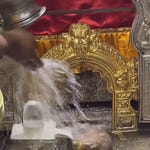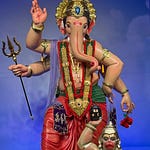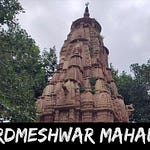Perched atop a verdant hill in the Kathmandu Valley, Swayambhunath Stupa—reverently known as Swoyambhu or the Monkey Temple—stands as one of the oldest and most revered spiritual landmarks in Nepal. Its iconic white dome, crowned with a gilded spire and the all-seeing eyes of the Buddha, watches peacefully over the capital city. For both Buddhists and Hindus, Swayambhunath is not just a monument, but a profound symbol of enlightenment, inner peace, and cosmic wisdom.
Origin and Foundation: The Self-Manifested Stupa
The name Swayambhu translates to "self-existent one" or "self-manifested," and this is central to its legend. According to the ancient Swayambhu Purana, the Kathmandu Valley was once a vast lake known as Nagadaha, filled with lotus flowers. Among them bloomed a miraculous, eternal flame or light known as Swayambhu Jyoti, believed to be the embodiment of divine wisdom.
The Bodhisattva Manjushree, upon a spiritual vision, journeyed from China to see this flame. He drained the lake by slicing through the hills with his mighty sword, allowing the water to flow out through what is now the Chovar Gorge. As the water receded, the lotus settled atop a hill and became the site of the Swayambhunath Stupa. Thus, the hill itself is considered a natural, living manifestation of the divine.
The stupa is believed to have been established over 2,500 years ago, though the earliest concrete structures are dated to the 5th century CE, built under the rule of King Vrsadeva of the Lichhavi dynasty. Over time, the site expanded into a rich complex of shrines, chaityas, temples, monasteries, and sacred symbols.
Timeline of Development and Restoration
~5th Century CE: Original foundation by King Vrsadeva, with stone inscriptions suggesting devotion to Swayambhu as early as this era.
7th Century CE onwards: Flourishing of Mahayana Buddhism in Nepal enhances the site’s significance.
14th Century CE: Extensive renovations by King Malla, following destruction by invasions.
17th Century CE: Emperor Pratap Malla built the eastern stairway, enhancing pilgrimage access.
20th Century: UNESCO designation and various international restoration efforts.
Recent Years: Restoration following the 2015 Nepal Earthquake ensured preservation of the stupa’s core and prayer infrastructure.
Architecture and Symbolism
The central stupa is a majestic dome-shaped structure representing the primordial womb of creation, resting on a whitewashed hemisphere. Above this rises a square tower painted with the mystical eyes of the Buddha, gazing in all four directions—symbolizing omniscience and spiritual awareness. Between the eyes is a symbol that looks like a question mark, but actually represents the Nepali number “1,” signifying unity of all things.
The thirteen tiers above the eyes represent the thirteen steps to enlightenment, ending in a gilded parasol—a crown-like symbol of attainment. Prayer flags flutter from the stupa to surrounding structures, carrying mantras through the wind, invoking blessings for all beings.
Surrounding the stupa are dozens of Buddhist and Hindu shrines, chaityas, and statues. The harmony of both religions coexisting here is unique and deeply symbolic of Nepal's syncretic spiritual culture.
Rituals and Daily Worship (Puja)
Devotees, monks, nuns, and tourists alike gather here daily, especially at dawn and dusk. The rituals are a blend of Tibetan Vajrayana Buddhist practices and Hindu offerings.
Kora (Circumambulation): Devotees walk clockwise around the stupa while spinning the 100+ prayer wheels inscribed with “Om Mani Padme Hum”, chanting prayers and meditating.
Lamp Offering (Butter Lamps): A sacred act where devotees light oil lamps to dispel darkness and seek enlightenment. Rows of glowing lamps are offered near shrines and under sacred trees.
Prayer Flags and Wheels: Spinning wheels and tying flags are part of offerings to the universe for peace and harmony.
Puja Offerings: Rice, flowers, fruits, and incense are offered with deep devotion. Monks perform chants, and sometimes rituals involve long ceremonial horns and drums.
Festivals: Buddha Jayanti, Lhosar (Tibetan New Year), and Gunla (Newar Buddhist festival) are celebrated with great fervor.
Religious and Spiritual Significance
To Buddhists, Swayambhunath represents the Buddha’s mind, and visiting it purifies negative karma and plants seeds of enlightenment. It is one of the most sacred pilgrimage sites for followers of Tibetan Buddhism, second only to Boudhanath.
To Hindus, the temple is also home to deities like Harati, the goddess who protects children, and several forms of Shiva and Vishnu, blending Vaishnav and Shaiva traditions with Buddhist reverence.
The entire hill is believed to emit spiritual energy, and meditating or praying here is considered highly meritorious. For many, it is a place where heaven and earth meet, where introspection becomes clear, and where the past and future dissolve into present mindfulness.
What to Do When Visiting
Walk the Kora: Always clockwise around the stupa. Spin each prayer wheel gently.
Light a Butter Lamp: As a symbolic gesture of removing ignorance.
Offer Prayers and Donations: Respectfully participate in prayers or donate for upkeep.
Visit Harati Devi Temple: Near the main stupa, especially if seeking blessings for children.
Observe Monastic Life: Watch monks chant or meditate in nearby monasteries.
Climb the 365 Steps: From the east, a steep but rewarding path. Alternatively, drive up the western entrance.
Buy a Sacred Souvenir: From local sellers, but do so respectfully.
Enjoy Panoramic Views: The hilltop offers breathtaking views of Kathmandu Valley.
What Not to Do
Do not touch sacred statues or relics without permission.
Avoid pointing your feet toward stupas or deities.
Do not take disrespectful photos, especially of monks during prayers.
Do not wear revealing clothing—modesty is key.
Avoid loud chatter or disrespectful behavior.
Do not litter or damage any part of the heritage site.
Timings and Best Time to Visit
Open daily from dawn to dusk.
Best hours: Early morning (5 AM to 8 AM) or late afternoon (4 PM to 6 PM) to witness prayers, fewer crowds, and golden light for photography.
Best season: Autumn (October–November) and Spring (March–April), offering clear skies and pleasant weather.
How to Reach
By Road: From Thamel or Durbar Square, it’s a 10–15 minute drive or 30-minute walk.
Public Transport: Local buses and taxis are available.
From Tribhuvan International Airport: Approx. 30 minutes by car.
Trekking Option: Enthusiasts sometimes include it as a detour on longer pilgrim or heritage walks.
Mysteries and Legends
Beyond history, Swayambhunath is enveloped in mysticism. Locals whisper of monks attaining miraculous powers, of wish-fulfilling trees, and of energetic auras felt during meditations. Some believe that spinning the prayer wheels here with a pure heart fulfills one’s deepest aspirations. The "eyes of the Buddha" are also said to penetrate one’s soul, gently reminding each visitor to seek inner truth.
Even the mischievous monkeys that roam the hill have spiritual significance. Believed to be descendants of Manjushree’s lice (from when he grew his hair long during meditation), these monkeys are now guardians of the sacred hill.
Glory Through the Ages
Swayambhunath has survived centuries of political shifts, earthquakes, and modernization—and yet, its glory has only deepened. It remains a UNESCO World Heritage Site, a spiritual magnet, and a global symbol of unity among multiple faiths. Pilgrims come not just for religion, but to feel a sense of transcendence, to reconnect with the sacred, and to remember the path of the Buddha amid daily life.
Why Devotees Hold It Close to Their Hearts
For countless Nepalese and Buddhists across the Himalayas, Swayambhu is a spiritual anchor. Life events like births, marriages, and even death rituals often involve a visit to this site. To pray here is to step into a space where karma transforms into compassion, where prayers are whispered with tears of hope, and where the ancient heartbeat of Kathmandu still pulses strong.
For every traveler or seeker, it offers not just breathtaking views and architecture, but a moment to pause, reflect, and awaken.










